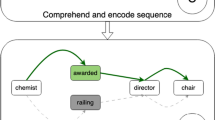Abstract
This paper explores the interaction between sentence level syntactic information and the semantic information that is carried with the verb during sentence comprehension. A cross-modal integration task was employed to examine whether the number of participant roles (thematic roles associated with the central meaning of the verb) causes an increase in processing load during integration of the verb into on-going sentence comprehension. The effect of preceding sentential structural information (varied with respect to the number of argument and/or adjunct NPs preceding the verb) was also manipulated. Independent of the structural information preceding the verb, verbs with two partici-pant roles were integrated into the sentence faster than verbs with three participant roles. This finding suggests that participant roles are stored with the representation of the verb and made immediately available during integration and comprehension. In addition, the syntactic distinction between arguments and adjuncts is also shown to play an immediate role in parsing and integration of language on-line.
Similar content being viewed by others
REFERENCES
Ahrens, K. (1995). The mental representation of verbs. Unpublished doctoral dissertation, University of California at San Diego.
Ahrens, K., & Swinney, D. (1995). Participant roles and the processing of verbs during sentence comprehension. Journal of Psycholinguistic Research, 24, 533-547.
Boland, J. (1991). The use of lexical knowledge in sentence processing. Unpublished doctoral dissertation, University of Rochester, New York.
Boland, J. (1993). The role of verb argument structure in sentence processing: Distinguishing between syntactic and semantic effects. Journal of Psycholinguistic Research, 22, 133-152.
Boland, J. (1997). The relationship between syntactic and semantic processes in sentence comprehension. Language and Cognitive Processes, 12, 423-484.
Carlson, G., & Tanenhaus, M. (1988). Thematic roles and language comprehension. In Syntax and semantics (Vol. 21, pp. 263-289). New York: Academic Press.
Chomsky, N. (1981). Lectures on government and binding. Dordrecht: Foris Publications.
DiSciullo, A., & Williams, E. (1987). On the definition of a word. Cambridge, MA: MIT Press.
Ferreira, F., & McClure, K. (1997). Processing of garden-path sentences with reciprocal verbs. Language and Cognitive Processes, 12, 273-306.
Fillmore, C. 1968. The case for case. In Bach & Harms (Eds.), Universals of linguistic theory. New York: Holt, Rinehart and Winstont.
Francis, W., & Kucera, H. (1982). Frequency analysis of English usage. Boston: Houghton-Mifflin.
Goldberg, A. (1992). Argument structure constructions. Unpublished doctoral dissertation, University of California, Berkeley.
Goldberg, A. (1995). Constructions: A construction grammar approach to argument structure. Chicago: University of Chicago Press.
Grimshaw, J. (1979). Complement selection and the lexicon. Linguistic Inquiry, 10, 279-326.
Hale, K., & Keyser, J. (1986). Some transitivity alternations in English. Lexicon Project Working Papers 7. Cambridge, MA: Center for Cognitive Science, MIT.
Hale, K., and Keyser, J. 1987. A view from the middle. Lexicon Project Working Papers 10, Cambridge, MA: Center for Cognitive Science, MIT.
Hale, K., & Keyser, J. (1993). On argument structure and the lexical expression of syntactic relations. In K. Hale & J. Keyser (Eds.), The view from building 20: Essays in honor of Sylvian Bromberger. Cambridge, MA: MIT Press.
Jurafsky, D. (1992). An on-line computational model of human sentence interpretation: A theory of the representation and use of linguistic knowledge. Unpublished doctoral dissertation, University of California at Berkeley.
Levin, B. (1985). Lexical semantics in review: An introduction. In B. Levin (Ed.), Lexical semantics in review, Lexicon Project Working Papers 1. Cambridge, MA: Center for Cognitive Science, MIT.
Levin, B., & Rappaport Hovav, M. (1995). Unaccusativity. Cambridge, MA: MIT Press.
Marslen-Wilson, W., & Tyler, L. K. (1980). The temporal structure of spoken language understanding. Cognition, 8, 1-71.
McRae, K. T., Ferretti, T., & Amyote L. (1997). Thematic roles as verb-specific concepts. Language and Cognitive Processes, 12, 137-176.
Melinger, A., & Mauner, G. (1999). When are implicit agents encoded? Evidence from cross-modal naming. Brain and Language, 68, 185-191.
Oxford Advanced Learner's Dictionary Third Edition. (1974). Oxford:Oxford University Press.
Pinker, S. (1989). Learnability and cognition. Cambridge, MA: MIT Press.
Pritchett, B. (1988). Garden path phenomena and the grammatical basis of language processing. Language, 64, 539-576.
Rappaport, M. & Levin, B. (1988). What to do with theta-roles. In W. Wilkins (Ed.), Syntax and semantics (Vol. 21). New York: Academic Press.
Rappaport Hovav, M., & Levin, B. (1998). Building verb meanings. In M. Butt & W. Geuder (Eds.), The projection of arguments: Lexical and compositional factors. Stanford, CA: CSLI Press.
Rappaport, M., Laughren, M., & Levin, B. (1987). Levels of lexical representation. Lexicon Project Working Papers 20. Cambridge, MA: Center for Cognitive Science, MIT.
Rappaport, M., Laughren, M. & Levin, B. (1993). Levels of lexical representation. In J. Pustejovsky (Ed.), Semantics and the lexicon. Dordrecht: Kluwer Academic Publishers.
Shapiro, L., Zurif, E., & Grimshaw, J. (1987). Sentence processing and the mental representation of verbs. Cognition. 27, 219-246.
Taraban, R. & McClelland, J. (1988). Constituent attachment and thematic role assignment in sentence processing: Influences of context-based expectations. Journal of Memory and Language, 27, 597-632.
Author information
Authors and Affiliations
Rights and permissions
About this article
Cite this article
Ahrens, K. Verbal Integration: The Interaction of Participant Roles and Sentential Argument Structure. J Psycholinguist Res 32, 497–516 (2003). https://doi.org/10.1023/A:1025452814385
Issue Date:
DOI: https://doi.org/10.1023/A:1025452814385




